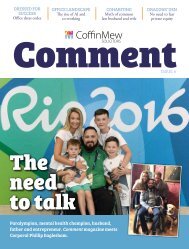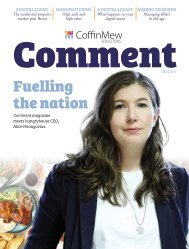Comment Magazine Issue 7
You also want an ePaper? Increase the reach of your titles
YUMPU automatically turns print PDFs into web optimized ePapers that Google loves.
What can businesses<br />
learn from Toblerone?<br />
Chocolate lovers everywhere were in uproar earlier<br />
this year when Mondelez International, makers of<br />
Toblerone, changed its shape. Budget high street<br />
retailer Poundland, spotting an opportunity, quickly<br />
launched its own version of the popular chocolate<br />
bar, calling it Twin Peaks. Equally quickly, Poundland<br />
found itself on the wrong end of a legal claim.<br />
There is a valuable lesson that businesses should<br />
learn when changing products, says Emma Stevens.<br />
Mondelez International, the makers<br />
of the Toblerone chocolate bars,<br />
in November 2016 changed the<br />
much-loved shape of its product<br />
from a row of 11 triangular chunks<br />
with distinctive peaks to a row<br />
of nine triangular chunks spaced<br />
further apart. The decision not only<br />
left chocolate lovers angry, it also<br />
left with them with a smaller bar of<br />
chocolate.<br />
Adding further to Mondelez’s<br />
misery, Poundland introduced its own<br />
version of the chocolate bar, called<br />
Twin Peaks, reportedly catering to<br />
a gap in the market created by the<br />
change of the Toblerone. Poundland’s<br />
bar features two rows of two joined-up<br />
peaks instead of one; its packaging<br />
is in red and gold and features two<br />
mountains, reportedly based on the<br />
peaks of the Wrekin Hill in Shropshire.<br />
The Twin Peaks bar was due to be<br />
launched in July, but was delayed<br />
when Mondelez brought a legal<br />
action to protect its intellectual<br />
property in the Toblerone bar.<br />
Mondelez first registered the<br />
distinctive Toblerone shape, with 12<br />
chunks rather than the 11 chunks<br />
sold in the UK since about 2010, as an<br />
EU-trade mark in 1997; the registration<br />
of the shape mark granted Mondelez<br />
the right to take legal action against<br />
anyone who tried to copy the shape<br />
of its Toblerone bar.<br />
It has since been reported that<br />
Mondelez has now issued a claim in<br />
the High Court against Poundland for<br />
damages on the basis of trade mark<br />
infringement of its registered shape<br />
and image marks. Mondelez argues<br />
that the Twin Peaks bar is “deceptively<br />
and confusingly similar” to Toblerone,<br />
in particular on the basis of its shape,<br />
packaging and logo. Poundland has<br />
defended the claim, saying that its<br />
chocolate bar is new and distinctive<br />
from the Toblerone shape.<br />
Interestingly, there may also be<br />
arguments that Mondelez has weakened<br />
its registered mark by changing the<br />
shape of the Toblerone bar.<br />
This is not the first time in recent<br />
years that big brands have made the<br />
headlines in relation to the shapes<br />
of their products, with Nestlé’s<br />
dispute with Cadbury regarding<br />
Nestlé’s attempted registration of<br />
the shape of its KitKat bar. In that<br />
case, the attempted registration<br />
was unsuccessful as the Court of<br />
Appeal found that the shape was not<br />
distinctive enough to be registered<br />
as a trade mark.<br />
What can businesses learn<br />
from Toblerone?<br />
Whilst shape marks have made<br />
the headlines, the range of marks<br />
which can be registered to protect<br />
intellectual property is much wider<br />
including words or phrases (word<br />
marks) and logos (image marks).<br />
With online and real-world<br />
infringement becoming increasingly<br />
common, owners of intellectual<br />
property must take steps to register<br />
and to protect their brands.<br />
Whilst it is possible to take action<br />
against copycat brands if words<br />
and logos are not registered, this<br />
is usually more difficult than if<br />
registrations are in place. The courts<br />
will require a number of elements<br />
to be established which are often<br />
difficult to demonstrate, including<br />
goodwill in the unregistered mark and<br />
a likelihood of confusion between the<br />
unregistered mark and the infringing<br />
one.<br />
When establishing a new product<br />
or brand it is sensible to complete<br />
thorough searches at the outset to<br />
ensure that your intended mark has<br />
not been registered previously and<br />
is not too similar to existing marks;<br />
failure to do this can lead to expensive<br />
litigation in the event that the mark<br />
inadvertently infringes an existing<br />
mark and the previously registered<br />
owner takes action to protect it.<br />
Similarly, ensuring marks are<br />
properly registered at an early stage<br />
can assist in protecting your brand;<br />
where infringement does occur, it is<br />
important to consider taking action<br />
swiftly to ensure that your brand and<br />
intellectual property are not damaged<br />
or devalued.<br />
The same applies following a<br />
rebrand or redesign, as Toblerone no<br />
doubt now recognises.<br />
Contact us direct<br />
Emma Stevens<br />
Associate Solicitor –<br />
Dispute Resolution<br />
023 8057 4303<br />
emmastevens@coffinmew.co.uk<br />
12<br />
13




